Performance Measures

Incidence of selected communicable diseases (Acute hepatitis
B; Cryptosporidiosis; and E.coli 0157) (Goal 2: PM#1)
These indicators measure the success of provincial health programs
in preventing and controlling selected communicable diseases.
Results
| Measure |
2002 Target |
2002 Actual |
Status |
Incidence of:
Acute hepatitis B |
2.6 cases per 100,000 population |
1.8 cases per 100,000 population (2002) |
Exceeded target |
Incidence of:
Cryptosporidiosis (a measure of drinking water quality) |
4 cases per 100,000 population |
3.1 cases per 100,000 population (2002) |
Exceeded target |
Incidence of:
E.coli 0157 (a measure of food safety) |
Rate to remain below 4 cases per 100,000
population |
3.4 cases per 100,000 population (2002) |
Exceeded target |
| Baseline: 2000 |
|
|
|
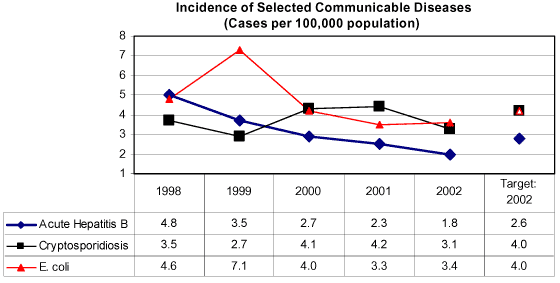
Source: Epidemiology Services,
BC Centre for Disease Control.
Potential Years of Life Lost (PYLL) due to cancer, heart disease,
and injuries (Goal 2: PM#2)
This indicator measures Potential Years of Life Lost (PYLL) for
selected causes, expressed as age-standardized rates per 1,000
standard population. PYLL is the number of years of life "lost"
when a person dies before an established cut-off point, in this
case, age 75. It focuses on premature deaths — deaths
that occur in the younger age groups and that can, in theory,
be prevented or at least postponed. PYLL is a generally accepted,
overall indicator of population health and is a good measure
of the effectiveness of prevention programs.
Cardiovascular disease, cancer, and injuries (external causes)
have been selected because they account for approximately two-thirds
of total PYLL (cardiovascular disease: 15%, cancer: 30%, injuries:
22%).
Note: The 2002 rate for injuries (external causes) is not yet
available as these deaths are subject to coroner review and may
require lengthy investigations before a final cause of death is
determined.
Results
| Measure |
2002 Target |
2002 Actual |
Status |
| PYLL due to cancer |
12.6 PYLL per 1,000 population |
11.9 PYLL per 1,000 population (2002) |
Exceeded target |
| PYLL due to cardio-vascular (heart) disease |
6.7 PYLL per 1,000 population |
5.9 PYLL per 1,000 population |
Exceeded target |
| PYLL due to injuries |
14.3 PYLL per 1,000 population |
Data not available until Fall 2003 |
Pending* |
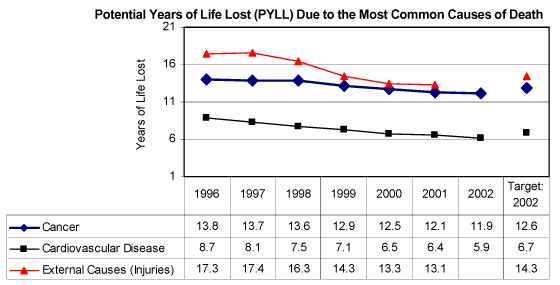
Source: BC Vital Statistics Agency

Immunization rates — 2 year olds with up-to-date immunizations
(Goal 2: PM#3a)
This indicator measures the effectiveness and use of immunization
programs. Low rates may indicate a problem in access or delivery
of these services. Immunization programs for children remain among
the most cost-effective ways to improve health status and reduce
health care costs. In BC, all infants and preschool children have
access to immunizations, protecting them from the following nine
serious diseases: diphtheria, tetanus, polio, pertussis, haemophilus
influenza type b, mumps, measles, rubella, and hepatitis B. (The
hepatitis B immunization program was implemented in 2001; data
is not yet available for this age group).
In 2001, about half of health regions estimated that over 80
per cent of children had been fully immunized by their second
birthday. In BC, while these programs are publicly funded, the
reported immunization rates for two-year-olds, while relatively
stable in recent years, show a slight decline for the second year
in a row. The reason for the decline is not known, but factors
that can influence immunization rates include concerns over the
efficacy and safety of vaccines and the perception certain diseases
are rare and no longer pose a threat to public health. The ministry
will be working with the BC Centre for Disease Control and health
authorities to examine the data and to ensure the decline in immunization
rates does not become a trend.
Note: For some areas of the province, immunization statistics
remain unavailable due to various data collection and retrieval
issues. The Ministry of Health Planning is reviewing methods to
support improved data reporting to improve accuracy.
Results
| 2002 Target |
2002 Actual |
Status |
| 82% |
DPTP: 81.1%
Hib: 81.7%
MMR/MR 80.5%
|
Missed target |
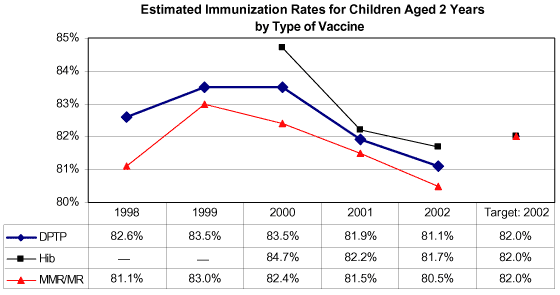
Source: Disease and Injury Prevention Branch, Ministry
of Health Services.

Immunization rates — Influenza vaccination, population
age 65 and over (Goal 2: PM#3b)
This indicator measures immunization rates for influenza vaccination
for persons 65 years of age and older. Influenza is a major cause
of illness, hospitalization and death among older adults. Annual
influenza vaccination reduces the risk of disease and may lessen
the severity of illness. It is also effective preparation for
an influenza pandemic, anticipated within the next five to ten
years. Full implementation of the immunization program —
with immunization of 80 per cent of adults age 65 and older —
could prevent half of the deaths, hospitalizations and physician
visits for influenza.
Results
| 2002 Target |
2002 Actual |
Status |
| 2% increase
Baseline: 2001
|
9.3% increase |
Exceeded target |
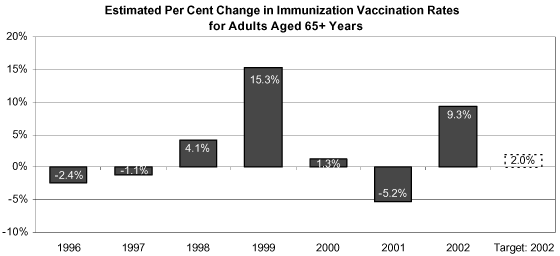
| |
1995 |
1996 |
1997 |
1998 |
1999 |
2000 |
2001 |
2002 |
| Influenza Vaccination Rate (65+) |
55.2% |
53.9% |
53.3% |
55.5% |
64.0% |
64.8% |
61.4% |
67.1% |
Source: Disease and Injury Prevention Branch, Ministry
of Health Services.
Utilization of screening programs for at risk groups (screening
mammography) (Goal 2: PM#4)
This indicator measures the use of mammograms to screen 50- to
74-year-old women every two years for cancer. It is calculated
as the number of women being screened at least once at a screening
mammography program facility (SMPBC), divided by the female population
in that age group. Screening mammography is an important service
for the early detection of illness, and reaching a larger proportion
of the population is important in improving population health.
The estimated biannual screening rate increased to 51 per cent
in 2001/02. Data for this measure is not yet available for 2002/03.
Results
| 2002 Target |
2002 Actual |
Status |
| 53%* |
Data for this measure is not available
for 2002/03. |
Pending** |
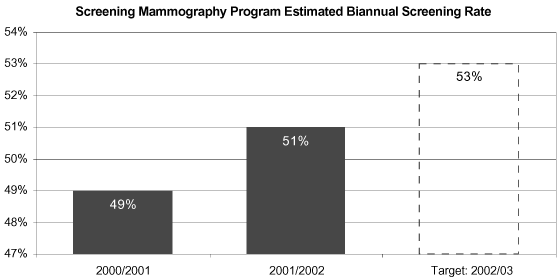
Source: SMPBC Trends, Health Data Warehouse; Population
data: BC Stats and Health Data Warehouse.
| Goal 2: Improved Health
and Wellness for British Columbians |
| Objective
2: Reduce inequalities in health status among specific
populations in British Columbia. |
| Strategies: |
|
|
• Support initiatives to improve Aboriginal health
through the formalized participation of Aboriginal people
in the planning and delivery of health care
|
Underway |
|
• Support initiatives to improve the health status
of people with mental illnesses.
|
Underway |
Achievements:
-
The Ministry of Health Planning is working with
Aboriginal health stakeholders to develop a Provincial Aboriginal
Health Services Strategy (PAHSS). This work will contribute
to Aboriginal health by increasing access to appropriate health
services, by enhancing participating of Aboriginal people in
decision making and by promoting better integration of Aboriginal
specific care with mainstream health care services and programs.
-
Honouring Our Health — An Aboriginal
Tobacco Strategy for BC was released in 2001. It is the
first of its kind in Canada and is currently being evaluated.
Health authorities have completed Aboriginal
Health Plans for each region, working with Aboriginal communities
and organizations.
-
The province is working with federal and First
Nations agencies to develop a comprehensive Aboriginal health
database to identify population, incidence of chronic diseases
and access to standardized treatment resources or protocols.
-
The province has distributed an Aboriginal Health
Care Service Provider Manual and First Nations Companion Handbook
to the BC HealthGuide.
-
A comprehensive mental health strategy was launched
to focus on: early detection and evidence-based care; develop
a permanent communications infrastructure to improve mental
health literacy; better integrate mental health care throughout
the health system; and focus on self-management and clinical
practice guidelines.
Performance Measures

Improved health status for Aboriginal peoples measured by
infant mortality and life expectancy (Goal 2: PM#7)
These indicators measure infant mortality and life expectancy rates
for Aboriginal peoples. As a group, Aboriginal peoples have a level
of health below that of the general population.
Infant Mortality Rate: The infant mortality rate for the
Aboriginal status Indian population in the province moved from a
high of 15.4 to a low of 4.0 during 1991 to 2001. The 2001 rate
of 4.3 infant deaths per 1,000 live births was only slightly higher
than the overall provincial rate of 4.0. Although, the gap has remained
relatively stable for the past three years, this is a vast improvement
over rates that were more than double the provincial rate in the
early 1990s. 2002 infant mortality rates data for Aboriginal peoples
is not yet available.
Life Expectancy: For British Columbians, life expectancy
(five-year average) has risen steadily in the last decade from 78.6
to 79.9 in the general population, and from 69.8 to 72.7 in the
status Indian population. Although still less than the general population,
the gap in life expectancy between the status Indian and general
population has decreased slightly in the last decade.
Results
| 2002/03 Target |
2002 Actual |
Status |
| Improvement in Status Indian infant mortality. |
Infant mortality per 1,000 live births in
2002:
Aboriginals: N/A
Total BC population: 4.4 per 1,000
|
Pending* |
| Improvement in Status Indian life expectancy,
from 1991-1999 baseline. |
Life expectancy in 2002:
Aboriginals: N/A
Total BC population: 80.2 years
|
Pending* |
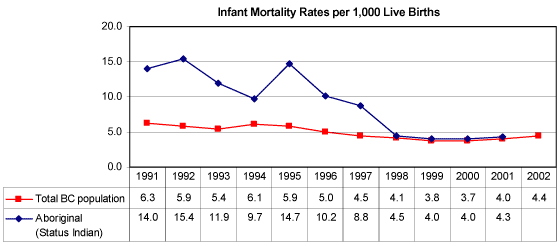
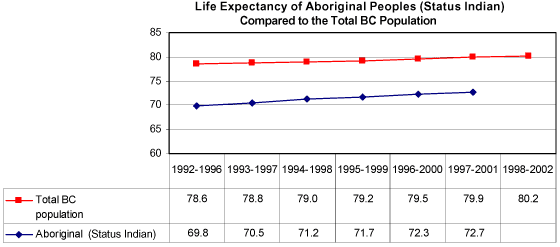
Source: BC Vital Statistics Agency, BC Stats.

| Goal
2: Improved Health and Wellness for British Columbians |
| Objective
3: People have the information they need to stay healthy. |
| Strategies: |
|
|
• Promote behaviors that decrease people's risk of
preventable illness.
|
Underway
|
Achievements:
- BC's Tobacco Control Strategy with performance indicators completed
and approved, in principle, by the Minister. It includes a three-part
approach: legislation and legal action to hold the industry accountable
for its actions; prevention, cessation and enforcement programs;
and public education.
- Under the Chronic Disease Prevention Strategy, the ministry
has formed a Provincial Chronic Disease Alliance and started drafting
evidence papers to track results of actions and interventions,
thereby evaluating their potential to reduce the burden of disease.
- Under the BC HealthGuide Program, since April 2001, over 1.8
million books have been distributed; more than 1,000,000 hits
have been made to BC HealthGuide OnLine; and 27,000 BC First
Nations Health Handbooks have been distributed to Aboriginal communities
throughout BC.
- Since opening, the BC NurseLine has provided health information
and advice to over 240,000 callers.
- Through the Provincial Chronic Disease Strategy, the province
provides Web-based access to information and tools for managing
chronic diseases.
- Action Schools! BC is an interministerial and community-based
initiative to promote physical activity among children and youth
in schools and through public education. A Web site and resources
have been developed as part of this project.
Performance Measures

Smoking rates (measured every 2 years) (Goal 2: PM#5)
This indicator measures the proportion of the population who are
current smokers (those who smoke cigarettes on either a daily or
occasional basis). Smoking is the most frequent cause of lung cancer
and chronic respiratory disease, and also increases the risk of
coronary heart disease, stroke, and Sudden Infant Death Syndrome
(SIDS). The rate of smoking in BC is currently the lowest in Canada
for the general population aged 15 years and older. Rates have been
dropping since 1994, suggesting that provincial programs to reduce
smoking have been effective.
Results
| 2002/03 Target |
2003 Actual |
Status |
| Smoking Rates for Adults
Reduce smoking prevalence by 1% from 2000 baseline to 19%
for population age 15 and older
|
Full year data not yet available for 2002 |
Pending* |
| Smoking Rates for Youth
Reduce smoking prevalence by 1% from 2000 baseline to 17%
for youth age 15 – 19
|
Full year data not yet available for 2002 |
Pending* |
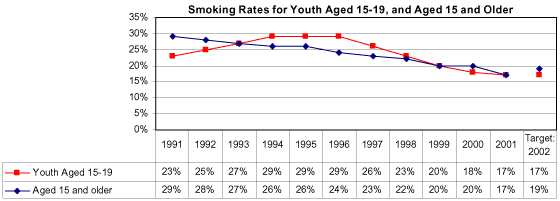
Source: Data for 1991: Statistics Canada, General Social
Survey (GSS). Data for 1994, 1996, and 1998: Statistics Canada,
NPHS. Data for 1999 to 2000: Health Canada, Canadian Tobacco Use
Monitoring Survey (CTUMS).
Rates of healthy behaviors and conditions (Goal 2: PM#6)
Physically Active: Percentage of population age 12 and older
physically active enough to attain health benefits (measured every
2 years).
Body Mass Index: Rates of healthy behaviors and conditions
— percentage of adults with a healthy body weight (measured
every 2 years).
This indicator measures the percentage of the population who have
an acceptable body weight and are physically active. Body Mass Index
(BMI) is an indicator of obesity and therefore an indicator of risk
for chronic disease in the adult population, particularly heart
disease and diabetes. (Healthy body weight is defined as a Body
Mass Index between 20.0 and 24.9.) Physical inactivity is also a
risk factor and indicator of population risk for future chronic
illness, such as heart disease, diabetes, and some cancers.
Data for these measures will be collected every two years through
the Canadian Community Health Survey. 2002/03 data will be available
next fall.
Results
| 2002/03 Target |
2002/03 Actual |
Status |
| Physically Active: Maintain at 27% |
Data not yet available for 2002/03 |
Pending* |
| BMI: Maintain at 45% |
Data not yet available for 2002/03 |
Pending* |
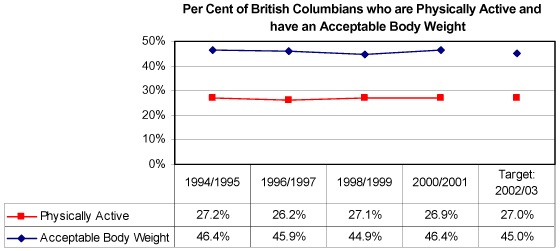
Source: Disease and Injury Prevention Branch
